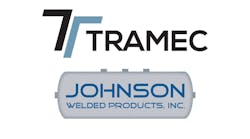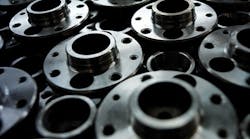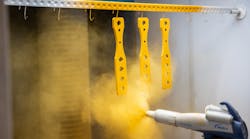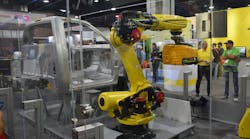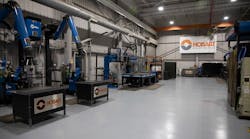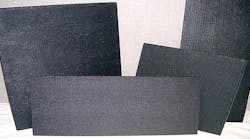INFRARED heating technology has become prevalent among industrial ovens, dryers, and heaters used by a multitude of industries ranging from metalworking, thermoforming, and printing, to the manufacture of adhesives or pulp and paper.
OEMs that manufacture these ovens and heaters use infrared heating elements, which are more energy-efficient, cheaper to operate, provide controllable heat, and are more environmentally friendly.
Infrared heating elements are available in standard, off-the-shelf designs such as flat panel models, but a host of custom infrared elements have been developed by OEM suppliers to meet unique requirements of specific applications.
Whether custom or off-the-shelf, properly sized, infrared heating elements can have dramatic, positive effects on the performance and even cost of the heating apparatus as well as its application. So it benefits the OEM to collaborate with its supplier before settling on element design specifications.
Standard or custom?
Oven/heater applications can vary widely among market segments, even within the same industry. For example, within the printing industry, different heaters or elements are used by screen printing, paper, and 3D printing industries.
“There may be some standard specifications within the OEM models available for some specific applications, but in many cases the OEMs don’t have the in-house technical resources to determine exactly whether an off-the-shelf element is suitable or if a custom design is required,” said Jesse Stricker, founder of INTEK Corporation (Union MO). “Or they may not have the experience to consider all of the intricacies of heat transfer, reflection and controls.”
INTEK is a manufacturer of heaters and elements for industrial ovens and dryers used in continuous process heating for production automation and material handling in a wide range of industries.
Stricker, who has been involved with the industrial heating field for more than 40 years, said that in many cases it is quite practical to tailor infrared heating elements to provide the exacting performance necessary for the heater/oven to provide optimum productivity and minimum downtime in a given application.
Whether standard or custom element design is anticipated, certain design criteria should be established with the element supplier at the outset.
“OEM designers sometimes use different terminology, so the first question we usually ask is ‘Do you need a filament, element or heater,’” said Stricker.
Basically, a filament is the bare heating wire (usually nichrome) that generally requires some sort of additional construction to provide a finished, usable element. An element generally consists of a filament wire encapsulated in a ceramic body or suspended by ceramic bushings and includes terminal wires necessary for connecting to supply power. Heaters generally consist of a heating element and insulation contained in a sheet metal housing suitable for installation using brackets or structural framework of some design.
Next, what is the desired size of the element which is determined by the actual heating surface needed for your application? What are the dimensions of the heater frame? Where will this be mounted or installed (allow necessary clearance for good fit)?
What are the electrical specifications: watts, volts, amps, ohms? Does it require single-phase or three-phase operation?
The next thing to be considered is how the filament, element or heater is connected to supply power and what the location is of each element lead wire, as well as the method of attachment or termination required.
“The element supplier should be able to resolve all of these (above) requirements,” said Stricker.
Confirming specifications
Whatever the element design specifications, they should be discussed and confirmed with the supplier whenever possible.
“I feel that the most effective way to provide support is through face-to-face meetings with the OEM’s design group. That may be a little bit more time-consuming, and may involve flying or driving some distance, but we feel it is important,” Stricker said. “Of course, in some instances Skype might be as effective as meeting the people in person.”
Stricker said INTEK also provides its OEM customers with an approval drawing for each new element design.
“The digital drawing illustrates our design discussions and how we understand the requirements of the application,” he said. “It is an important tool that helps us obtain customer approval before going into production.”
Value-added services can in some cases be vital to the success of a customer/supplier relationship. For example, they can include extra services or assurances that supplies will be available when required.
When his company completes a design they offer to stock the element so customers won’t have delivery problems. This service is performed in several different stages; raw materials, work in progress, and finished goods are all kept on hand. This type of service enables OEM customers to meet their delivery requirements just in time when they are in short supply.
Stricker said it is important to OEMs that suppliers maintain strict confidentiality regarding product designs, applications, and financial arrangements.
For more information, contact INTEK, 290 Independence Drive, Union MO 63084; phone 636-584-8500, toll-free 800-387-8559; fax 636-584-8503; email [email protected]; or access www.intekcorp.com. ♦
